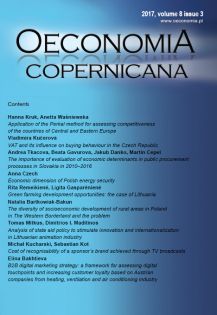Analysis of state aid policy to stimulate innovation and internationalization in Lithuanian animation industry
Analysis of state aid policy to stimulate innovation and internationalization in Lithuanian animation industry
Author(s): Tomas Mitkus, Dimitrios Ioannis MaditinosSubject(s): Supranational / Global Economy, Business Economy / Management, Visual Arts, Film / Cinema / Cinematography, Migration Studies, Accounting - Business Administration
Published by: Instytut Badań Gospodarczych
Keywords: creative industries; animation; internationalization; film industry; management;
Summary/Abstract: Research background: In order to achieve systematic development and growth of creative industries, instead of its being a random process, effective cultural policy tools need to be implemented. This task is greatly burdened by the fact that creative industries are a heterogeneous concept. Evidence suggests that indirect state aid is one of the most effective ways to stimulate growth and development of audiovisual segment. Lithuanian indirect state aid case suggests that there is still a great deal of confusion and misconception with the implementation and exploitation of this tool.Purpose of the article: To analyze how effectively indirect state aid is constructed to stimulate growth and development of the Lithuanian animation industry.Methods: This paper uses two methods to gather data. The first one is a quantitative questionnaire design to evaluate the overall situation of Lithuanian animation industry. The second method involves qualitative semi-structured interviews to collect specific data about Lithuanian film tax incentive from representatives of government institutions that administrate local fiscal incentive scheme and representatives of audiovisual industries.Findings & Value added: Results show that although Lithuanian film tax incentive can be considered as a successful cultural policy tool that brought a noticeable inward investment to the local film industry and economy in general, it had no positive effect on the local animation industry. The gathered evidence suggests that indirect aid tool should be constructed with more of surgical precision for each industry, rather than a fit-for-all cultural policy tool.
Journal: Oeconomia Copernicana
- Issue Year: 8/2017
- Issue No: 3
- Page Range: 433-446
- Page Count: 14
- Language: English

